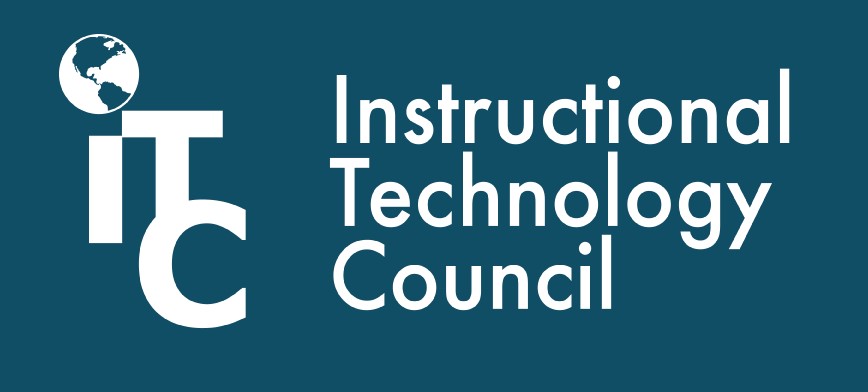As the pandemic spread across America in March 2020, community colleges and universities made a rapid and dramatic shift from the traditional to the virtual classroom. Already overworked distance learning programs now had the task of moving faculty that had resisted teaching online to go fully online.
The same was true for students, although to be honest, students had always been more accepting of online learning and the use of technology in instruction.
At the time, the hope/expectation was that we would just do this to complete the 2020 spring term. Given the intensity and duration of the pandemic, campuses stayed online for the 2020 fall term as well as the 2021 spring term. Some serious transitioning to the traditional classroom started with 2021 summer sessions but targeted “hands-on” classes.
Editor’s note: This article is provided by the Instructional Technology Council, an affiliated council of the American Association of Community Colleges.
Starting with the 2021 fall term, a growing number of campuses did their best to move more of their enrollments back to the traditional classroom albeit with mask and social distancing requirements and, for some, vaccinations. For most, it has been a struggle staving off Covid outbreaks, and both faculty and students have dealt significant uncertainty. It is also evident that we are not there yet – the hoped-for return to “normal” continues to be kicked down the road like the proverbial can as our society struggles with achieving herd immunization as well as the ever-evolving variants to the Covid virus.
What we’ve learned
At this juncture, we can begin to assess what we have learned from this intriguing power shift in instruction so far. One very key lesson learned to date during the pandemic: the technology divide is indeed real and continues to create a serious problem in technology equity amongst students and even faculty.
Many community college administrators realized this from the start. Either through the use of federal CARE funding or by utilizing existing resources available on college campuses, there was a concerted effort to make devices – and access to the Internet – available to students in need. This was a good thing of course. Our students were trying to use their smart phones to participate in Zoom classes and for submitting classwork, and they were often sitting in cars outside fast food restaurants offering free wi-fi to do so.
The ability for campuses to make devices and access available via check-out services was a laudable act, but there were also many community colleges that simply did not have the resources to do this. It created a critical equity of access issue for many of their students and contributed to adverse impacts on performance and completion.
Related article: DEI and distance learning: Emerging strategies for success
Similarly, most of our colleges have ignored the equity gap in technology for our faculty as well. The focus for full-time faculty has been to ensure a level of technology for their offices and classrooms. Few were forward-thinking enough to anticipate the need for faculty to work from home. Only a relative handful of colleges offered incentives to maintain updated technology at home. And in doing so, only for full-time faculty.
Our part-time faculty have been, for the most part, left to their own to obtain the devices and access they needed to teach. Many of our colleges also failed to implement mandatory training for online instruction be required of all full-time AND part-time faculty. As a result, the March 2020 exodus to the virtual classroom exacerbated significant digital divide issues for faculty as well.
What to do about it
The equity issue will not go away with any return to normalcy. Even pre-pandemic, the technology divide was present on all of our campuses. It was just easier to ignore. Now we know, and each campus is challenged to develop an action plan that addresses its particular technology gaps.
Overall recommendations to better prepare our campuses for the next shutdown (yes, there will be more shutdowns like March 2020) include:
- Develop a formal action plan to identify the specifics of the technology divide for students and faculty at your institution.
- Identify resources that will be needed to both address the immediate problem and establish long-term resources to support life-cycle replacement and increased bandwidth needs for the three key constituencies: the institution, the faculty and the students. In this regard, you may be able to use federal funds allocated during the pandemic. The HEERF (Higher Education Emergency Relief Funds) money could be a great place to start in finding needed resources to address the problem. If your institution doesn’t have a student technology fee, this may be the time to establish one. For faculty, you already have life-cycle replacement funding, but you will want to augment that to not only include devices, but assistance with credible wi-fi access as well for both faculty and students.
- Reconsider the “standard PC on the faculty desk” for full-time colleagues with laptops and a docking station/monitor for them to connect to when on campus. That way, they have a reliable computer solution for working at home in good times and being able to function professionally during bad times. For part-time faculty, perhaps a device check-out program for them along with a hotspot (as you did for your students), would be advisable. Not every part-time faculty member will need it (same is true for your students), but this gesture will go a long way in addressing the divide by providing the devices/access needed to be successful.
- A growing number of campuses are looking into a standard issue laptop and hotspot for every student. Yes, these can be difficult programs to administer, but you have the experience of many K-12 districts and universities that have been doing this for a while. Alternatively, you can seek partnerships from the private sector for both devices and wi-fi access, but the subsidy approach will not fully address the problem.
Take a deeper dive
It is critical that each campus take a deep dive into the technology divide issue that exist for their students and faculty. Open dialog to fully understand how this impacts performance and completion for students as well as teaching effectiveness for faculty is paramount to identifying workable solutions.
Yes, we can expect improved broadband because of the recently approved Infrastructure Act, but that will take time and may never really address the divide borne out of poverty – which is a major issue for many of our students. Taking action now will not only improve the technology equity climate on your campus but will also better prepare you for the next major shutdown of your campus. Something to think about.






